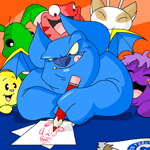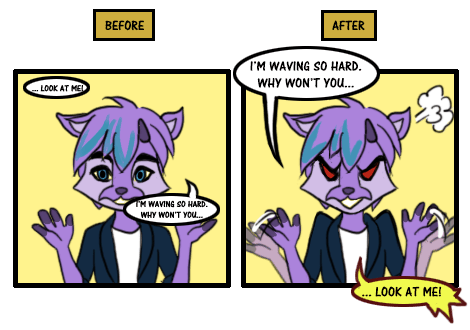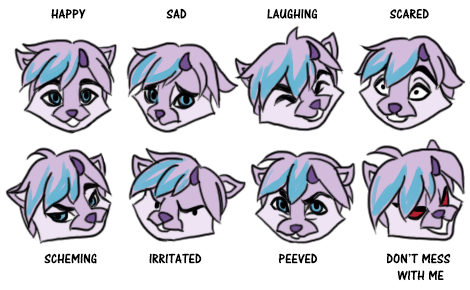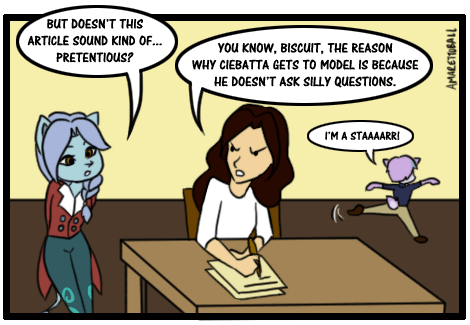 The Comic Artist's Handbook
by amarettoball
--------
On a previous visit to the Neopian Times Headquarters, I had debunked several myths regarding getting published in Neopia's premiere newspaper. After the publication of that article, a few readers have mentioned that I should elaborate more on how to make comics, and they offered to provide me with a lifetime supply of Soy Chai Lattes if I did so. Thus, for purely altruistic reasons (and totally not because I have a caffeine addiction to feed), I took up my drawing pens and went full speed ahead on fulfilling this request.The first and foremost tip I can give on creating successful comics is actually quite simple and fun: read lots of comics! A budding comic artist cannot underestimate the benefits of scouring the plethora of comics in the archives or rereading their favorite comic strips. The more comics you read, the better understanding you'll have of things like: how many panels you should use, where to place them, how to pace your story, where to put your text, how to express vivid emotions or actions, and more. It is similar to how good writers will read a lot, and good coffee connoisseurs will most definitely drink a lot of coffee. Make sure to get familiar with your drawing media, whichever one you use! The most common form you see is digital art, which is done entirely on the computer. However, there are plenty of hand-drawn comics that are just as visually appealing and/or funny. You can also do a mixture of both, if you prefer to sketch on paper and then color on the computer. Just make sure that if your comics are entirely scanned, the pictures themselves should have solid, clean lines. No heavy shadows or smudges obscuring the majority of your comic! For your convenience, I have also prepared a few tips regarding effective comic-drawing techniques. I'd like to note that these tips won't necessarily guarantee that your piece will get accepted, but they will assist you in getting there. Since comics are visual, it only makes sense that these tips also be illustrated, right? So first, I'll present to you a sample panel featuring my Ixi, Ciebatta, both before and after improvements are made. We will then break down these adjustments one by one.  Readable Text Bubbles. Making sure your text is clear and legible is one of the most crucial aspects of your comic. On the left, we see that the text is too small and too close to the edges of the speech bubbles to even be read. On the right, the text was adjusted from nine-point to fourteen-point font, and the speech bubbles were enlarged so that the text is not touching the edges. If you are handwriting your lines, make sure all of the letters are neat, readable, and smudge-free. In addition, the dialogue was originally out of order. Words are read from left to right and top to bottom, so it is best if you orient your text in a manner that flows from the top left of the panel to the bottom right. Avoid using arrows or numbers to signify the order that the speech should be read in, as it detracts from the flow of the story. Instead, try to draw the character that's speaking first on the left, and the character that's speaking next will follow on the right, so text will inevitably flow from left to right. Finally, speech bubbles should not block the action going on in each panel. In the "before" image, one of the bubbles is slightly blocking Ciebatta's face. In the second panel, all bubbles were moved so that they weren't obscuring the character, but the tails of the speech bubbles were still pointing to Ciebatta's mouth so you knew that he was talking. A bonus tip regarding the comic script is to make your speech as succinct as possible. That is, if there are lines that the comic does not need in order for the story to move along, it is best to remove them. After all, readers like comics because they want to focus on the images, not walls of text! Showing Actions. Remember those cheesy old comics that had characters punching with windmill arms, or looking dazed with birds tweeting and stars spinning around their heads? Since comics aren't animated, artists need effective ways of portraying action. In the above example on the left, Ciebatta is verbally saying that he's waving really hard, but he doesn't look like he's doing it. On the right, we see a better representation of him waving furiously, as well as a puff of steam emanating from his head to show that he's agitated. Of course, it's perfectly fine to leave him as he is on the left if you have trouble thinking of how to better illustrate his actions! But using these effects is very helpful in bettering your readers' understanding of what's going on. On the flip side, there are definitely instances where you can use too many "action lines," which will make your comics seem overloaded and confusing. When in doubt, ask for a friend to help you review the comic and have them note anything that they didn't understand. Vivid Expressions. Another way to demonstrate the mood of a scene is to draw your character's facial expressions to match his or her emotions. In the panel on the left, Ciebatta looks pretty neutral, and you can't really tell if he's agitated or not. In the panel on the right, his brows are furrowed, shoulders are tensed, and mouth is open as if he were shouting. Of course, visualizing facial expressions might not come easy to most people. The good news is that there's an infinite number of ways to portray each emotion, and all of them are equally great ways to show how your character is feeling. The best way to learn how to draw them would be to read other comics or graphic novels and use good expressions as references. You can even study the faces of your friends and see how their features change with their mood! Here are a few more examples of common facial expressions:  There are tons of simple things you can do to completely transform a character's emotions, such as slanting the eyebrows downward to show frustration. A narrowing of the eyes can further emphasize an angry look, or it can even be translated into a more sly expression, such as in the "scheming" face above. When pets are scared, their pupils might blow out to a small point, and their eyebrows will be raised. You can also incorporate ears into your emotions and make them droop when your characters are sad or frightened, or stick straight up when they're happy or excited. Aside from the technical aspects of comic-drawing, there are a few points about characters and story that I would like to address: You don't have to stick to one cast of characters! Just like writing a short story or series for the Neopian Times, you don't have to use the same characters for every comic . You can use your pets, established Neopian characters, or even make up your own snot-painted, caffeine-crazy ones if none of the existing pets give you inspiration. Comics can be stand-alone or part of a series, and you only have to consider using the same characters if you are planning on creating a series with plot continuity. Comics don't have to be funny. While the vast majority of comics intend to give readers a chuckle or two, you can totally skip the pun in favor of, say, a heartwarming message about the true meaning of Christmas, or how passionate you are about grinding your coffee by hand every morning, etc. The trick is that the comic has to be a good story with a clear beginning, middle and end, and there should be some thoughtful message behind it. You don't have to be a professional artist to draw a comic. A lot of Neopians seem to underestimate their own artistic abilities when it comes to creating comics. How well a reader can understand the joke or message is just as important as the actual art itself. Even then, the art can be as simple as you want, as long as you've put a lot of effort into drawing it and our resident Neopian Times editor, Country Queen, can understand it. If all else fails, ask for a second opinion! So you've mustered up the courage to finally draw a comic and consider submitting it. However, you're still nervous as to how your work will be received. This is where the Neopian community comes in--there are plenty of avid comic fans in your circle of friends, Neopian Writers Board, or Art Board who would love to review it for you! Ask around for anybody that would be interested, and post your piece on a spare petpage for them to view. Don't be afraid of critique! Whether or not you take others' suggestions is entirely up to you, but you may find that other readers have an eye for details different than your own. These are just a few tips covering the basics of comic-drawing. There are many more aspects I could rabidly expound on, but this should arm you with a good general guideline, so I'll stop my over-caffeinated self for now. Hopefully you aspiring artists found this article helpful in one way or another. Good luck in your pun-filled endeavors, and remember not to drink too much coffee when you're drawing, as those jittery hands make for some very interesting pictures!  Author's Note: A special thanks to twillieblossoms, june_scarlet, phoenix_through_fire, and chasing_stars44 for their valuable review and input into this article!
|